Campus Technology 2006: A Hit in Boston
New Conference Format Drives Change
Campus Technology 2006 :: Boston, MA
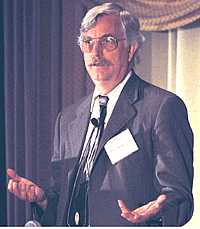
The More MUVEs, the Merrier
At the
Campus Technology 2006 conference held July 31-August
3 in Boston, Harvard University (MA) education technology
visionary Chris Dede’s opening keynote (left) set the
stage for a week of dynamic, panel-only discussions about
the changing face of technology on campus. Dede punctuated
his talk, “Get Ready for a Sea-Change in Education:
Immersive Learning Environments Across Cyberspace,”
with examples of multi-user virtual environments (MUVEs)
that now exist in real time across cyberspace. What a way
to launch three days of innovation sharing!
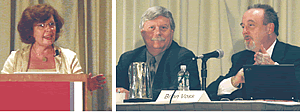
Ready for Anything?
Not all change is
planned or good, and CIOs have to be ready for contingencies.
Middle Tennessee State University CIO Lucinda Lea
(left) interviewed two Louisiana CIOs at the technology
helm of their respective institutions during Hurricane
Katrina. Former Tulane University (LA) CIO John Lawson
(center) emphasized a flexible disaster preparedness
plan, while Louisiana State University CIO Brian Voss
(right) surprised hundreds of attendees by cautioning
against “over-focusing” on survival issues at the
expense of the IT to-do list.
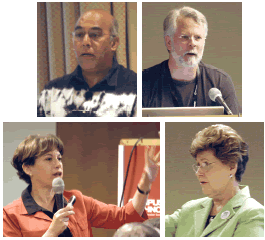
Workshops Abound.
A day of pre-conference, teamfocused
workshops allowed attendees
to stretch their imaginations.
(Top left to bottom right: Vijay Kumar, MIT; Phil
Long, MIT; Lori Breslow, MIT; Judith Boettcher, Designing for Learning
and the University of Florida.)
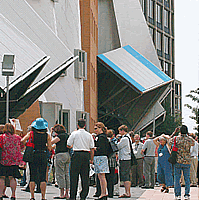
New Learning Spaces.
MIT’s Phil
Long led an extensive
walking tour of the university’s
extraordinary learning
spaces. Attendees
clamored to visit places
like the world-renowned
Stata Center (left), teeming with labs,
programs, and public
spaces. Tour participants
left inspired and energized.
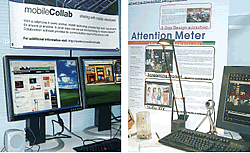
Media Lab Research.
A tour of MIT’s Media Lab gave attendees
a real behind-the-scenes glimpse of research in areas like contextaware
computing (left) and multimodal interaction (right).
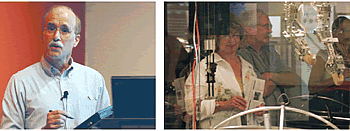
Ideas on Display.
Wrapping
up an afternoon of tours with an exclusive
reception at the MIT Museum,
attendees were treated to special presentations
by MIT iCampus PIs. MIT’s
Randall Davis (left), professor of
computer science and engineering,
fielded questions about Magic Paper
and sketch recognition software. Attendees
were enthralled (right).
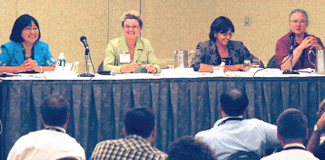
New Leaders.
Looking toward the
future yet mindful of change, Tufts University
(MA) CIO Mely Tynan (far left) and a panel
of three IT leaders—at different places in
their own career paths—discussed how to
develop the next generation of IT leadership
in higher ed. Panelists included (center left
to right) University of Minnesota’s Linda
Jorn, Cornell’s (NY) Joan Falkenberg Getman,
and Annie Stunden, recently retired
from the University of Wisconsin-Madison.
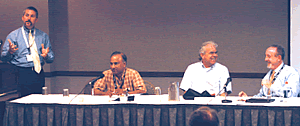
A Performance to Support HPC.
Indiana University’s Matt
Link (far left) led a robust
discussion of strategies to
support high-performance
computing on campus. Panelists
included (left to right)
Vijay Agarwala (Penn State),
Jim Pepin (University of
Southern California), and
LSU’s Brian Voss.
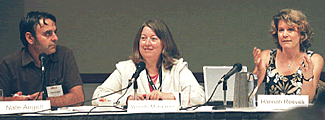
The Future Opens Up.
From Portland State
University (OR), Nate Angell
(left) and Wende Morgaine
(center) shared their ample
expertise with large-scale
open source implementations.
They were joined by
rSmart’s senior education consultant,
Hannah Reeves (right).
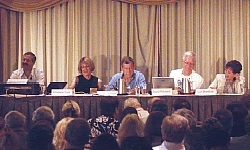
Assessment Experts.
MIT’s
David Singer (center),
assistant professor of
political science,
assembled a large
panel of his peers to
discuss the need for
informed assessment
strategies. The panel
included (left to right)
Steven Lerman,
Kimberle Koile, David
Pritchard, and Lori
Breslow.
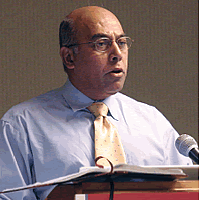
Looking Ahead with Vision.
At the conference’s closing
plenary—a “visions” panel—moderator Vijay Kumar (left) asked panelists and
attendees to reflect on what they had heard during the conference and project
possible future scenarios. Kumar invited them to engage constructively in crafting
a “preferred future,” and act as futurists, thus allowing possibilities to
seem more real for their own campuses.
Audience and panel observations, questions,
and insights propelled all into the future.
Excerpts follow:
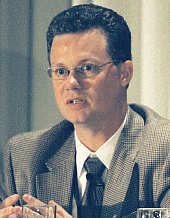
Wake Forest University’s (NC) Jay Dominick
Wake Forest University’s (NC) Jay Dominick (left) maintained
that the academy was built on the
scarcity of information, with libraries developing
in the 1400s and 1500s around collections
of text. But the scarcity of text has
disappeared, he pointed out. So, “how do we
help our organizations figure out what tomorrow is about?” he asked his audience.
And how will ubiquitous technologies (where connectivity and collectivity rule, rather
than place) affect what institutions will look like in a generation or so?
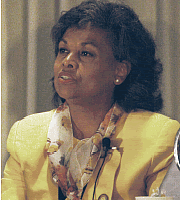
Rochester Institute of Technology’s (NY) Diane Barbour
Reflecting on security issues and the “dark side” of technology,
Barbour (left) pointed out, “Security is surrounding everything that we do; it has
to be a focus for us going forward. We really have to be proactive and go out
there and find ways to prevent [bad] things
from happening,” she said, “as opposed to fixing
them after something bad has happened.”
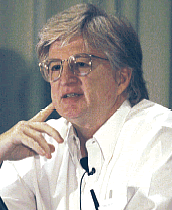
University of Texas-Austin’s Dan Updegrove
University of Texas-Austin’s
Dan Updegrove (left) insisted that
the new technology is going to come, and “we
are going to have no idea what it’s going to look
like.” But he observed that one of the messages
of the last five years is that there are fundamental
social forces that we have to respond
to. “I’m convinced that one of them is accountability;
we have to be in a position to support
the assessment of our entire enterprise in front
of the increasingly critical eyes of society.”
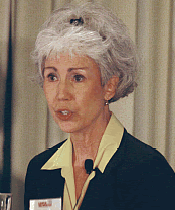
University of Georgia’s Barbara White
University of Georgia’s Barbara White (left) focused on
research computing and suggested, “In order for us to be competitive in a 21st-century
research environment, we’ve got to learn the language [specifically for]
high-performance computing, [and understand] the role and scope of research
computing and/or the role of high-performance computing. And we have to make
a sustainable business case.”
See you next year at Campus Technology 2007 in Washington, DC, July 30-August 2!